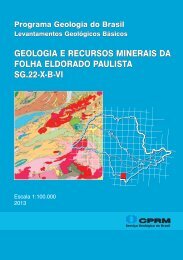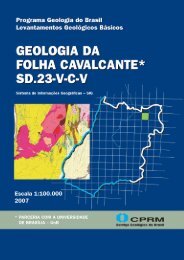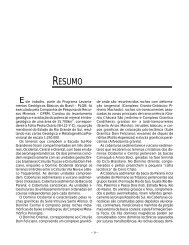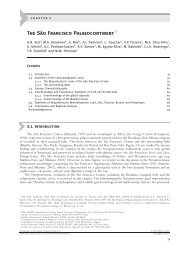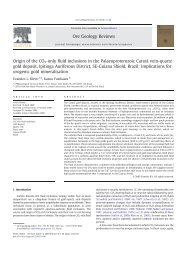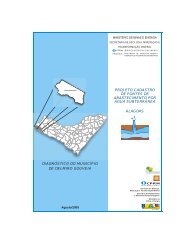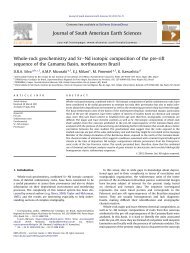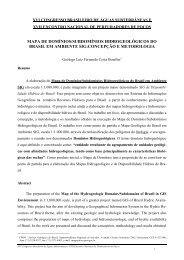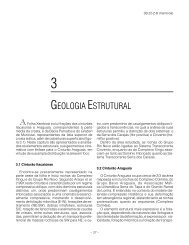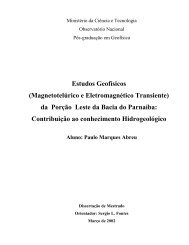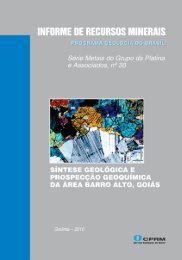Mercury and Methylmercury in Long Island Sound - CPRM
Mercury and Methylmercury in Long Island Sound - CPRM
Mercury and Methylmercury in Long Island Sound - CPRM
You also want an ePaper? Increase the reach of your titles
YUMPU automatically turns print PDFs into web optimized ePapers that Google loves.
METHODS<br />
Elemental Hg measurements were made dur<strong>in</strong>g a series of 3-4 day cruises on LIS with an<br />
automated gaseous elemental mercury analyzer (AGEMS) developed by our laboratory, <strong>and</strong> us<strong>in</strong>g<br />
traditional methods <strong>in</strong> the laboratory (Rolfhus & Fitzgerald, <strong>in</strong> review). Earlier Hg 0 measurements, as<br />
well as measurement of other Hg species, were made between 1995 <strong>and</strong> 1997. Atmospheric Hg <strong>in</strong>puts<br />
to LIS were assessed by total Hg determ<strong>in</strong>ations <strong>in</strong> bulk deposition samplers sited at 4 locations on the<br />
north shore of the <strong>Sound</strong> over an 18 month period. Total, reactive <strong>and</strong> MMHg concentrations were<br />
determ<strong>in</strong>ed <strong>in</strong> samples from 4 target rivers, at sites above the salt <strong>in</strong>trusion. The Connecticut River was<br />
more extensively sampled over 14 months dur<strong>in</strong>g representative flow regimes. Additionally, Hg species<br />
determ<strong>in</strong>ations were made <strong>in</strong> effluent from 7 water treatment facilities <strong>in</strong> Connecticut, as well as at<br />
multiple locations <strong>in</strong> the waters of LIS over a period of 26 months (V<strong>and</strong>al et al., <strong>in</strong> prep.).<br />
RESULTS AND DISCUSSION<br />
Our research has yielded useful first-order biogeochemical mass balances (i.e., sources <strong>and</strong><br />
s<strong>in</strong>ks) for total <strong>and</strong> MMHg <strong>in</strong> LIS. The estimated current annual Hg load<strong>in</strong>gs to LIS are approximately<br />
230 kg, of which about 75% (180 kg) is of pollutant orig<strong>in</strong>. The pr<strong>in</strong>cipal sources of Hg to the <strong>Sound</strong><br />
are wastewater treatment facilities, (WTFs, ~85 kg y -1 ; 38%), rivers (~120 kg y -1 ; 52%), <strong>and</strong> direct<br />
atmospheric deposition (~26 kg y -1 ; 10%) (V<strong>and</strong>al et al., <strong>in</strong> prep.; Fitzgerald et al., <strong>in</strong> press) (Figure 1).<br />
More than 85% of WTF flux (i.e., ~74 kg y -1 ) is estimated to be from NY sewage facilities discharg<strong>in</strong>g<br />
<strong>in</strong>to the East River <strong>and</strong> consequently <strong>in</strong>to the western <strong>Sound</strong>. River<strong>in</strong>e fluxes at ~120 kg y -1 are the<br />
major Hg source to LIS. The Connecticut River contributes about 70% of this <strong>in</strong>put (~84 kg y -1 ).<br />
Direct wet atmospheric Hg deposition is a relatively small <strong>in</strong>put to the <strong>Sound</strong>. However, deposition of<br />
Hg to the watershed <strong>and</strong> subsequent leach<strong>in</strong>g is an important contributor to the Hg load<strong>in</strong>gs via rivers.<br />
We suggest that the estimated Hg flux from the Connecticut River could be due entirely to its watershed<br />
if 25% of the atmospheric Hg load<strong>in</strong>gs runs off.<br />
Although the mass balance needs constra<strong>in</strong>ts, the pr<strong>in</strong>cipal external sources (~4 kg y -1 ) of<br />
MMHg to the <strong>Sound</strong> are WTFs (~1.4 kg y -1 ; 35%), rivers (~1.6 kg y -1 ; 40%), <strong>and</strong> direct atmospheric<br />
deposition at about ~0.7 kg y -1 (18%)(V<strong>and</strong>al et al., <strong>in</strong> prep.; Figure 2). Our marsh <strong>and</strong> near shore<br />
studies suggest that the major source of MMHg <strong>in</strong> LIS is <strong>in</strong>ternal production. Studies of net Hg methylation<br />
<strong>in</strong> two Connecticut salt marshes po<strong>in</strong>t to nearshore sedimentary regimes as regions of significant<br />
production (Langer et al., <strong>in</strong> press). We hypothesize that as much as 6 to 18 kg y -1 of MMHg are<br />
formed through the microbial conversion of reactive mercury (Hg ) species <strong>in</strong>to MMHg <strong>in</strong> shallow<br />
R<br />
sedimentary regions of LIS. Net <strong>in</strong> situ microbially mediated MMHg production may be two to five<br />
times greater than the fluxes from rivers, sewage, <strong>and</strong> the atmosphere. The pr<strong>in</strong>cipal source of this toxic<br />
species <strong>in</strong> mar<strong>in</strong>e aquatic systems is <strong>in</strong> situ biologically-mediated conversion of Hg . Sulfate reduc<strong>in</strong>g<br />
R<br />
bacteria (SRB) have been implicated as the primary synthesizers. The aqueous production of Hg 0<br />
competes for reactant (i.e., ionic Hg or Hg ) with the <strong>in</strong> situ biological synthesis of MMHg, such that<br />
R<br />
water bodies with a large production of Hg 0 may have smaller amounts of MMHg <strong>in</strong> biota <strong>and</strong> accumulation<br />
<strong>in</strong> the sediment.<br />
Elemental Hg is nearly always found to be supersaturated (72-1154%) <strong>in</strong> LIS (Figure 3),<br />
<strong>in</strong>dicat<strong>in</strong>g reduction of ionic Hg (reactant). General trends <strong>in</strong>clude higher supersaturation dur<strong>in</strong>g warmer<br />
months <strong>and</strong> <strong>in</strong> the middle of the <strong>Sound</strong> near the mouth of the Connecticut River (Rolfhus & Fitzgerald, <strong>in</strong><br />
review). Supersaturation of Hg 0 suggests Hg is lost from the <strong>Sound</strong> to the atmosphere via evasion.<br />
Wann<strong>in</strong>khof (1992) is currently our gas exchange “model of choice” based on its wide acceptance <strong>and</strong><br />
successful application to other gases. Evasional flux estimates (122-822 pmol m -2 d -1 ) for each of the



